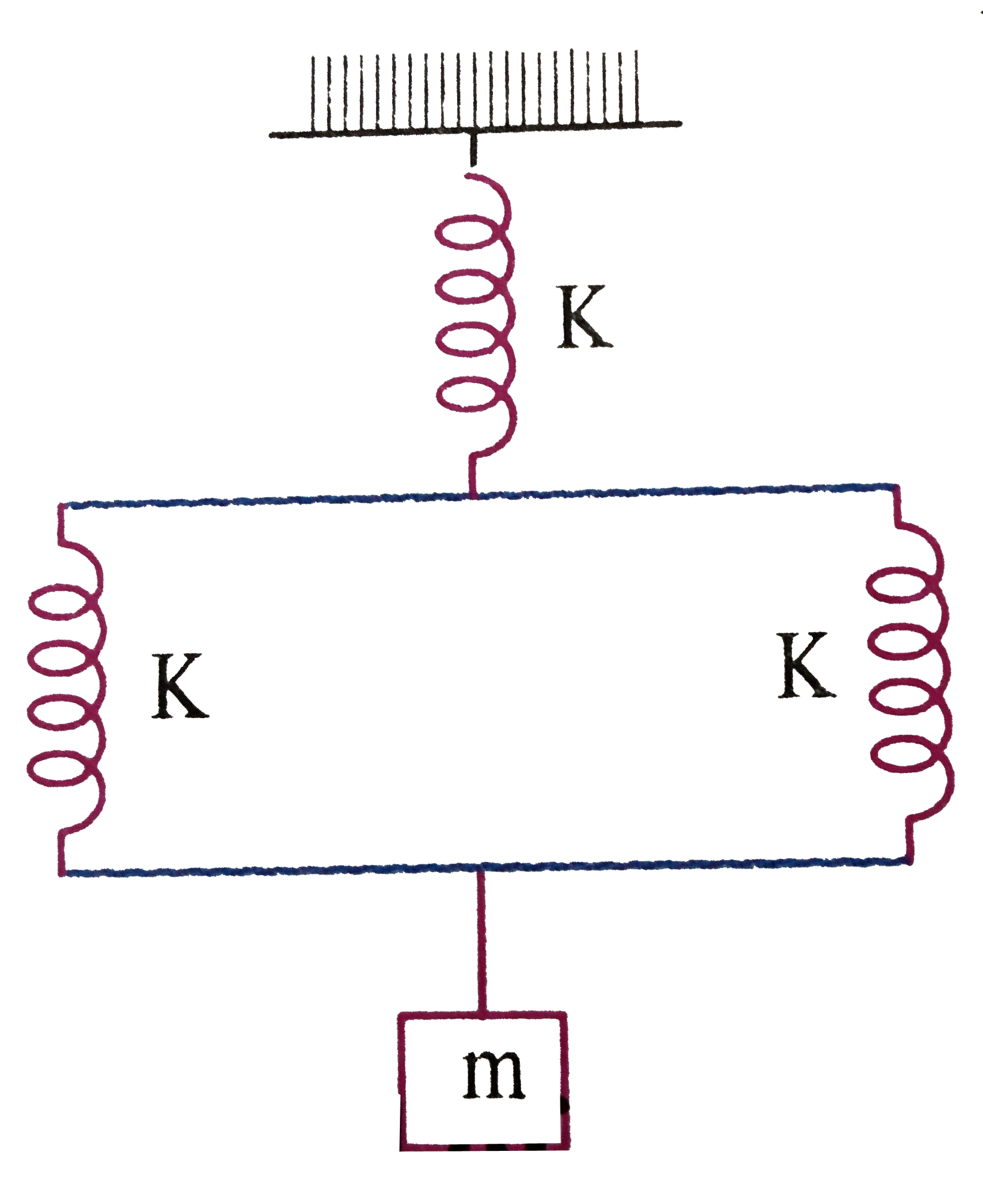Periodic time of oscillation T1 is obtained when a mass is suspended from a spring and if another spring is used with same mass then periodic time of oscillation is T2 . Now if this mass is suspended from series combination of above springs then calculated the time period.
To solve the problem of finding the time period of oscillation when a mass is suspended from a series combination of two springs, we can follow these steps:
1. Understanding the Time Period for a Single Spring:
The time period T of a mass M suspended from a spring with spring constant K is given by the formula:
T=2π√MK
For the first spring, we have:
T1=2π√MK1
For the second spring, we have:
T2=2π√MK2
2. Finding the Spring Constants:
Rearranging the formulas for T1 and T2, we can express the spring constants K1 and K2 in terms of the mass M and the time periods T1 and T2:
K1=4π2MT21
K2=4π2MT22
3. Effective Spring Constant for Series Combination:
When two springs are combined in series, the effective spring constant Keffective is given by:
1Keffective=1K1+1K2
This can be rewritten as:
Keffective=K1K2K1+K2
4. Substituting the Values of K1 and K2:
Substituting the expressions for K1 and K2 into the formula for Keffective:
Keffective=(4π2MT21)(4π2MT22)4π2MT21+4π2MT22
Simplifying this gives:
Keffective=16π4M24π2MT21+4π2MT22
Cancelling 4π2M from the numerator and denominator:
Keffective=4π2M1T21+1T22
5. Finding the Time Period for the Series Combination:
Now, we can find the time period T for the effective spring constant:
T=2π√MKeffective
Substituting Keffective:
T=2π
⎷M4π2M1T21+1T22
This simplifies to:
T=2π
⎷M⋅1T21+1T224π2M
Further simplifying gives:
T=2π
⎷14π2(1T21+1T22)
Finally, we arrive at:
T=√T21+T22
Final Answer:
The time period of oscillation when the mass is suspended from the series combination of the two springs is:
T=√T21+T22
The time period T of a mass M suspended from a spring with spring constant K is given by the formula:
T=2π√MK
For the first spring, we have:
T1=2π√MK1
For the second spring, we have:
T2=2π√MK2
Rearranging the formulas for T1 and T2, we can express the spring constants K1 and K2 in terms of the mass M and the time periods T1 and T2:
K1=4π2MT21
K2=4π2MT22
When two springs are combined in series, the effective spring constant Keffective is given by:
1Keffective=1K1+1K2
This can be rewritten as:
Keffective=K1K2K1+K2
Substituting the expressions for K1 and K2 into the formula for Keffective:
Keffective=(4π2MT21)(4π2MT22)4π2MT21+4π2MT22
Simplifying this gives:
Keffective=16π4M24π2MT21+4π2MT22
Cancelling 4π2M from the numerator and denominator:
Keffective=4π2M1T21+1T22
Now, we can find the time period T for the effective spring constant:
T=2π√MKeffective
Substituting Keffective:
T=2π
⎷M4π2M1T21+1T22
This simplifies to:
T=2π
⎷M⋅1T21+1T224π2M
Further simplifying gives:
T=2π
⎷14π2(1T21+1T22)
Finally, we arrive at:
T=√T21+T22
The time period of oscillation when the mass is suspended from the series combination of the two springs is:
T=√T21+T22
Similar Questions
Periodic time of oscillation T1 is obtained when a mass is suspended from a spring if another spring is used with same mass then periodic time of oscillation is T2. Now if this mass is suspended from series combination of above spring then calculate the time period.
View Solution
The period of oscillation of a mass M suspended from a spring of spring constant K is T. the time period of oscillation of combined blocks is
View Solution
Knowledge Check
A body of mass m is suspended from three springs as shown in figure. If mass m is displaced slightly then time period of oscillation is
 A2π√m3KB2π√3m2KC2π√2m3KD2π√3Km
A2π√m3KB2π√3m2KC2π√2m3KD2π√3KmThe period of oscillation of mass M suspended from a spring of negligible mass is T. If along with it another mass M is also suspended, the period of oscillation will now be
ATBT/√2C2TD√2TLet T1andT2 be the periods of springs A and B when mass M is suspended from one end of each spring. If both springs are taken in series and the same mass A is, suspended from the séries combination, the time period is T, then
AT=T1+T2B1T=1T1+1T2CT2=T21+T22D1T2=1T21+1T2
Oscillations of a mass suspended from a vertical spring is ……………………………motion.
View SolutionWhen a mass M is suspended from a spring, its period of oscillation is 2 second. If a mass 4 M is suspended from the same spring, then its period of oscillation will be
View SolutionIf the period of oscillation of mass M suspended from a spring is one second, then the period of 4M will be
View SolutionA mass is suspended from a spring have spring constant k is displaced veritcally and relased it oscillates with period T the weight of the mass suspended is (g= gravitatioanal acceleration)
View SolutionA mass is suspended from a spring have spring constant k is displaced veritcally and relased it oscillates with period T the weight of the mass suspended is (g= gravitatioanal acceleration)
View Solution